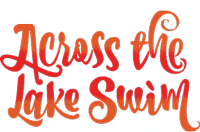Anxious Swimmer Lesson 3
Lesson 3: Swimming Straight and Sighting
Review of Lesson 1: Equipment, Pop up drill, recovery position. Are you all comfortable with a recovery position? If you are, you should not need to put your feet down at any point while swimming.
Review of Lesson 2: Breathing issues—two different kinds of breathing (chest and abdominal), big inhalation in through the mouth using the chest, complete emptying with the diaphragm, humming and snorting, keeping breathing under control over distance, varying breathing cadence. And we have done some sighting practice as well.
Are you all getting out on your own to practice? What are your main sticking points so far?
At this point you are all at different comfort levels—so we may need to break up the group into different needs.
- Who here wants to continue to work at getting breathing under control?
- Who wants to work on more sighting drills, and integrate variable breathing cadence with sighting?
- Who thinks they can do 800m continuously, sighting along the buoys, without putting their feet down?
Today’s basics: how to swim straight.
The shortest distance between two points is a straight line. Although the ATLS is 2.1 km, most people make it a longer swim because they do not swim straight. This adds to your swim time in the water as well.
So how do we swim straight if there is no line underneath us to guide us?
- You could just take one look and just keep your head down, and hope you are swimming in a straight line, or
- You could get your bearings regularly by popping up to have a look at where you are going
It is useful for you to know if you have a tendency to swim slightly to the left or to the right. Most of us do this because of either slight asymmetry in our arm movements side to side, or slight differences in our strength side to side, or a bit of both—and both can be affected by your wetsuit fit. The more you swim, the more that improves.
Lets get in the water, acclimatize, and meet at the 0m buoy.
- How straight do you swim?
Start at the 0m buoy, and look at the direction of the 50m buoy. Now swim towards it without looking for 40-50 arm strokes. Where did you wind up? To the left or to the right of your intended target? Were you close or not? Did you try to use other things to guide you—like the ripples in the sand? or shadows and sunlight?If you are a big drifter, you may need to correct your swimming by looking up more often than someone who does not deviate much. Unfortunately, the more you have to lift your head up to sight, the more your body position is affected, and the slower you go, so it is important to learning the mechanics necessary to swim straight. - Sighting techniques
Sighting is the process where you pop your head up briefly to get your bearings, to hone in on the target you are swimming toward, whether that is a buoy, or a landmark or a finish line.You should have a good idea of what you are looking for before you get into the water! Scout out your swim ahead of time.Two basic sighting techniques:
Easiest: Attach your sighting head movement to your turning to breathe movement. Just crane your neck upward and look forward before you turn to breathe. You can learn to do this on both sides if you breathe symmetrically (every three arm strokes).
More difficult: “Alligator eyes” between strokes—your eyes sit just above the surface between arm strokes, not associated with a breath cycle. This is most effective when waters are calm and no one is in front of you, and it minimizes any body position disruption.
In both cases, you have only a second to capture a “snapshot” of what is in front of you, a picture you can process for the next few seconds while you decide whether to make any small corrections to your swim course.
- Sighting in chop, waves, and swells
With mild chop, or when needing to see over a swimmer in front of you, you may need to lift your head slightly higher out of the water to find your target, or consider looking for a more distant landmark that is in line with your swim goal, such as a tree or building on land, or a mountain peak.Sighting gets harder in wavy water, or when there are swells. You have to learn to feel if you are in a trough or on the crest of a wave or swell, and time your sighting to maximize your ability to see what you need to see. Otherwise you will only see water. - More distance practice
Time to use your sighting techniques to the test, buoy by buoy for the 800m loop. See if you can read each buoy’s meter measure as you swim by it, and without breaking your swim rhythm.
Practice on your own this week!
